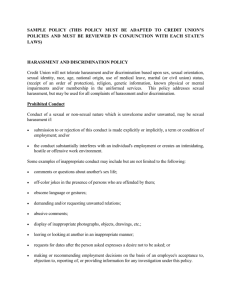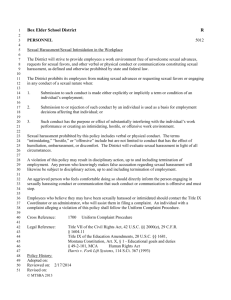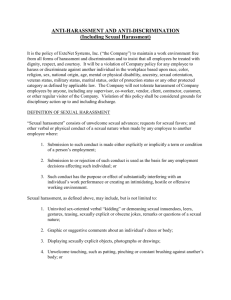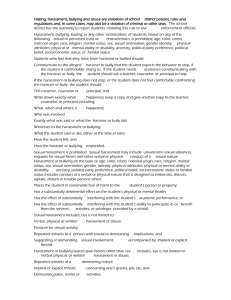policy directive no
advertisement
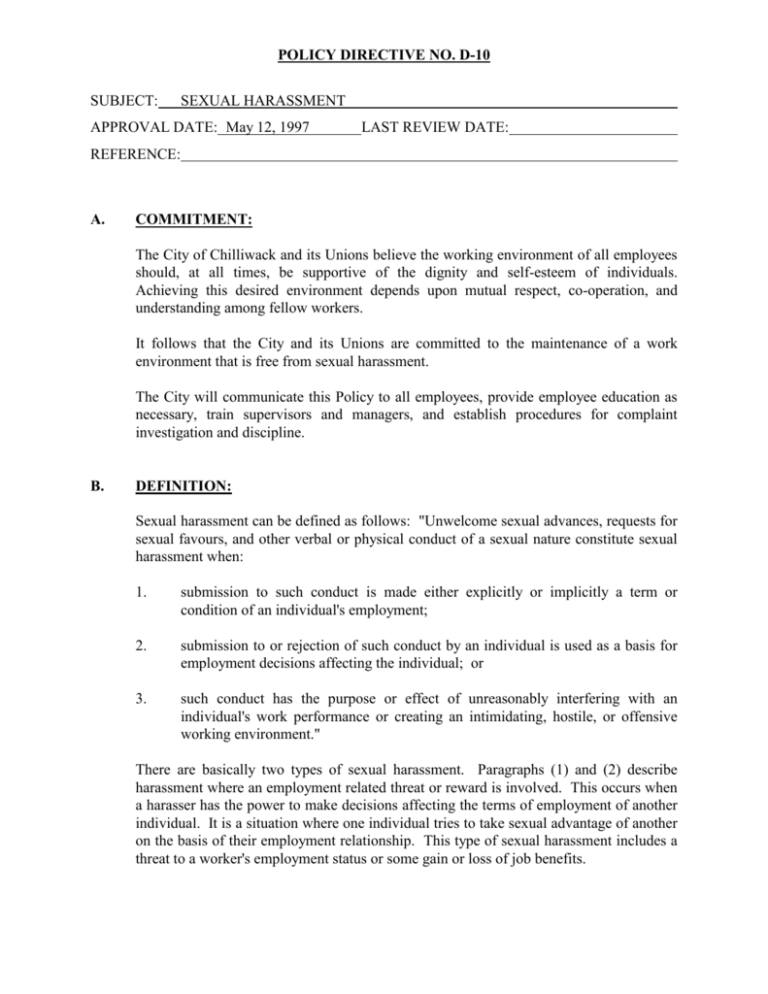
POLICY DIRECTIVE NO. D-10 SUBJECT: SEXUAL HARASSMENT APPROVAL DATE: May 12, 1997 LAST REVIEW DATE: REFERENCE: A. COMMITMENT: The City of Chilliwack and its Unions believe the working environment of all employees should, at all times, be supportive of the dignity and self-esteem of individuals. Achieving this desired environment depends upon mutual respect, co-operation, and understanding among fellow workers. It follows that the City and its Unions are committed to the maintenance of a work environment that is free from sexual harassment. The City will communicate this Policy to all employees, provide employee education as necessary, train supervisors and managers, and establish procedures for complaint investigation and discipline. B. DEFINITION: Sexual harassment can be defined as follows: "Unwelcome sexual advances, requests for sexual favours, and other verbal or physical conduct of a sexual nature constitute sexual harassment when: 1. submission to such conduct is made either explicitly or implicitly a term or condition of an individual's employment; 2. submission to or rejection of such conduct by an individual is used as a basis for employment decisions affecting the individual; or 3. such conduct has the purpose or effect of unreasonably interfering with an individual's work performance or creating an intimidating, hostile, or offensive working environment." There are basically two types of sexual harassment. Paragraphs (1) and (2) describe harassment where an employment related threat or reward is involved. This occurs when a harasser has the power to make decisions affecting the terms of employment of another individual. It is a situation where one individual tries to take sexual advantage of another on the basis of their employment relationship. This type of sexual harassment includes a threat to a worker's employment status or some gain or loss of job benefits. Policy Directive D-10 SEXUAL HARASSMENT Page 2 of 5 DEFINITION (continued) Paragraph (3) refers to harassment which has the effect of "poisoning" the work environment. It arises when words or conduct create an unpleasant or objectionable work environment. It usually does not involve threat of reprisal per se, but makes enduring it an unavoidable aspect of employment. The victim of sexual harassment may be male or female. The harasser may be of the same or opposite sex of the victim. The harasser may be a manager, supervisor, co-worker, or subordinate. Examples of sexual harassment may include the following: (a) Verbal: (i) (ii) (iii) (iv) (v) (vi) (vii) (viii) (b) Physical: (i) (ii) (iii) (iv) (v) (vi) (vii) (viii) (ix) C. unwelcome remarks; gender based insults or sexist remarks; proposals of physical intimacy; requests for sexual favours; jokes causing awkwardness or embarrassment; innuendoes or taunting; telephone calls with sexual overtones; repeated unwelcome requests for dates. pinching; hugging; leering; touching; grabbing; patting; brushing against; kissing; displaying pornographic or other offensive or derogatory pictures or cartoons or sayings. PREVENTION: The City of Chilliwack and its Unions are committed to a sexual harassment free workplace. 1. Information: (a) A policy statement in pamphlet form will be distributed to all employees. Policy Directive D-10 SEXUAL HARASSMENT Page 3 of 5 PREVENTION (continued) (b) 2. Training: (a) D. Information sessions will be offered to supervisors, managers and employees about sexual harassment in the workplace, its prevention, its eradication and the complaint procedure. Workshops for all supervisors, managers and employees will include recognition of potential problems and liability, enforcing the City Policy, and keeping employees informed. PROCEDURE FOR COMPLAINT, INVESTIGATION AND REMEDY: Sexual harassment is one of the most sensitive issues in the workplace. Because of this, a complaint procedure must be flexible to apply to all situations. To be truly effective, a procedure must be accessible on several levels. It must be immediately available, totally confidential initially and provide a mechanism for investigation. It must consider penalties for harassers and remedies for victims. It should be separate and distinct from any other existing procedures. Accordingly, the City's procedure is not meant to be restrictive. It is acknowledged that an employee may want to follow a Union complaint procedure. A harassee may prefer to talk initially to his or her supervisor or Director, to the Corporate Services Department, or to the Chief Administrative Officer, in effect to invent his or her own procedure. What follows does not prohibit that. However, it is presented as a recommended procedure which is likely to be effective in most instances. 1. Communicate to the individual that his or her behaviour is unwelcome and ask him or her to STOP (verbally and/or in writing). 2. A victim of sexual harassment may take the initial complaint to his or her supervisor, union representative or to the Director of Corporate Services. 3. In an environment of confidentiality, the complainant and the initial contact, along with the Director of Corporate Services, will review the definition of sexual harassment. The Director of Corporate Services will outline the complaint procedures available. 4. The Director of Corporate Services will discuss alternative courses of action with the complainant. The complainant may wish to discuss the issue directly with the harasser (with the option of support from the initial contact or the Director of Corporate Services) in order to arrive at a solution, or the preference may be to begin an investigation. Alternatively, the complainant may wish to consider the matter further, initiate a grievance, or stop the process. Policy Directive D-10 SEXUAL HARASSMENT Page 4 of 5 PROCEDURE (continued) 5. At the request of the complainant, an investigation will be undertaken. At this point, it will be necessary to record the complaint in writing. Once the investigation has begun, the complainant's identity will be made known to the alleged harasser. 6. The investigation will be conducted by the Director of Corporate Services and a Union Representative (if applicable) with the assistance of other City staff during the investigation as he or she sees fit. Interviews will be held with the alleged harasser and with other staff as necessary. 7. Once the investigation has been completed, the findings will be reported to the complainant, the alleged harasser and the Chief Administrative Officer. An attempt will be made to resolve the issue at this time. 8. If the investigation reveals evidence to support the complaint of sexual harassment, the harasser will be disciplined appropriately. Discipline may include suspension or dismissal and the incident will be documented in the harasser's file. No documentation whatsoever will be placed in the complainant's file regardless of the outcome, unless the complaint is found to be malicious and unfounded. 9. If the matters remain unresolved the Director of Corporate Services will submit a written report to the Chief Administrative Officer, outlining the facts, the issues and a recommended resolution. 10. The Chief Administrative Officer will decide the matter. The employee will have access to the grievance procedure where applicable. 11. If the investigation fails to find evidence to support the complaint, there will be NO documentation concerning the complaint placed in the file of the alleged harasser. 12. Regardless of the outcome of a sexual harassment complaint made in good faith, the employee lodging the complaint, as well as anyone providing information, will be protected from any form of retaliation by either co-workers or supervisors. This includes demotion, unwanted transfer, denial of opportunities within the City, as well as harassment of the individual as a result of his or her having made a complaint or having provided evidence regarding the complaint. Policy Directive D-10 SEXUAL HARASSMENT Page 5 of 5 PROCEDURE (continued) 13. E. In keeping with the commitment of the City and its Unions to the elimination of sexual harassment in the workplace, it is understood and implied that remedial action is intended in all cases to be appropriate to the situation. It is the expressed agreement of both Unions and Management that remedies may range from warning to dismissal. Where changes in the workplace are made necessary by demonstrated sexual harassment, the harasser shall bear the consequences of those changes. CONCLUSION: In promulgating this Policy, the City of Chilliwack is demonstrating its determination to provide a professional workplace free from sexual harassment. A complaint procedure has been provided to deal with such incidents as may occur, with provision for discipline if an employee is in breach of this Policy. Provision is also made to change situations where sexual harassment occurs, and to educate employees, supervisors, and Directors of all relevant aspects of sexual harassment. In all these ways, the goal of the Policy is prevention. ______________________________ Chief Administrative Officer


